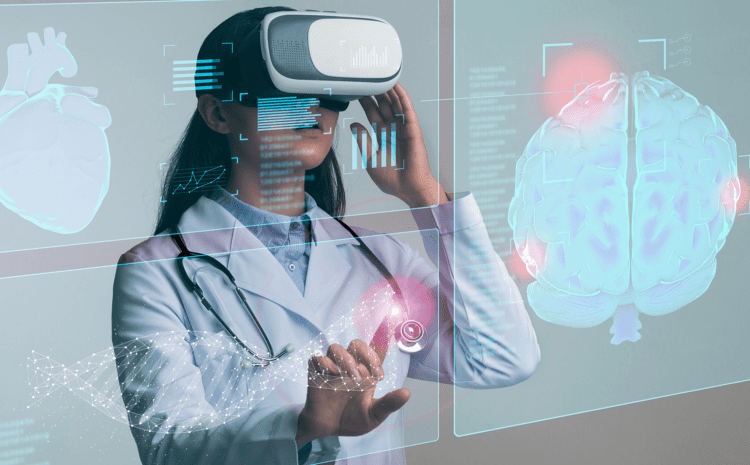Virtual Reality (VR) is not just transforming the entertainment industry; it is making waves in healthcare and wellness by offering new, innovative ways to diagnose, treat, and manage medical conditions. At MirrAR, where our mission is to build deeply immersive digital experiences that are highly engaging, we see the power of VR in medicine as a game-changer that is revolutionizing how healthcare is delivered. This article explores the profound impact VR is having on healthcare and wellness, and how it is reshaping the future of medicine.
The Evolution of VR in Healthcare
VR technology has evolved rapidly over the past few years, transitioning from a tool primarily used for gaming and entertainment to a sophisticated platform with significant medical applications. VR’s ability to create realistic, immersive simulations has opened up new possibilities in medical training, patient treatment, and wellness therapies.
In medical training, VR provides students and professionals with a safe, controlled environment to practice surgical procedures, explore human anatomy, and learn complex techniques without the risk of harming patients. VR-based simulations are now an integral part of many medical curricula, allowing trainees to gain hands-on experience in a virtual setting before moving on to real-life scenarios.
VR in Surgical Training and Planning
One of the most revolutionary applications of VR in medicine is in surgical training and planning. Surgeons can now use VR to rehearse complex procedures in a 3D environment that mimics the human body with incredible accuracy. This not only enhances the surgeon’s skills but also reduces the likelihood of errors during actual surgeries.
Moreover, VR enables surgeons to visualize the patient’s anatomy in 3D before making any incisions, which aids in precise surgical planning. For instance, VR can be used to create a virtual model of a patient’s heart before performing delicate cardiac surgery, allowing the surgical team to plan and practice the procedure in advance. At MirrAR, we believe that such applications of VR are not just enhancing medical outcomes but are also setting new standards in patient safety and care.
Pain Management and Rehabilitation
Another significant area where VR is making a difference is in pain management and rehabilitation. VR has been found to be effective in reducing chronic pain by diverting the patient’s attention away from pain signals and immersing them in a calming, interactive environment. This method, often referred to as VR distraction therapy, has shown promising results in managing pain for burn victims, cancer patients, and individuals suffering from chronic pain conditions.
In rehabilitation, VR is being used to help patients recover from strokes, brain injuries, and orthopedic surgeries. Through interactive VR exercises, patients can regain motor skills and coordination in a virtual environment tailored to their specific needs. These exercises are often more engaging than traditional physical therapy, leading to better patient compliance and faster recovery times.
Mental Health and Wellness
VR is also playing a crucial role in the treatment of mental health conditions such as anxiety, PTSD, and phobias. Through exposure therapy, VR allows patients to confront and manage their fears in a controlled, virtual environment. For example, a patient with a fear of heights can be gradually exposed to height-related scenarios in VR, helping them to overcome their phobia over time.
In wellness, VR is being used to promote mindfulness and relaxation. Virtual environments that simulate serene landscapes or guided meditation sessions can help individuals reduce stress, improve mental clarity, and achieve a greater sense of well-being. At MirrAR, we are committed to harnessing the power of VR to create wellness experiences that are not only immersive but also profoundly beneficial for mental health.
Also Read: The Science Behind AR Virtual Try-Ons and Customer Psychology in the Jewelry Business
VR in Patient Education and Consultation
One of the less talked about but equally important applications of VR in medicine is in patient education and consultation. VR allows healthcare providers to explain complex medical conditions and procedures to patients in a more understandable way. By visualizing their condition in 3D, patients can gain a better understanding of their diagnosis and treatment options, leading to more informed decisions and better adherence to treatment plans.
For example, a patient diagnosed with a tumor can be shown a virtual model of their tumor, helping them to visualize its location, size, and the planned surgical procedure to remove it. This approach not only enhances patient understanding but also reduces anxiety by providing clarity on what to expect during treatment.
The Future of VR in Healthcare
The potential of VR in healthcare is vast and still largely untapped. As the technology continues to evolve, we can expect to see even more innovative applications that will further revolutionize medical practice. From remote surgery and telemedicine to personalized wellness programs, VR is set to transform every aspect of healthcare.
At MirrAR, we are at the forefront of this transformation, leveraging VR to create digital experiences that are not only engaging but also life-changing. Our mission is to explore the full potential of VR in healthcare, pushing the boundaries of what’s possible to improve patient outcomes and enhance the overall well-being of individuals around the world.
Conclusion
Virtual Reality is revolutionizing healthcare and wellness by offering new, immersive ways to treat and manage medical conditions. From surgical training and pain management to mental health and patient education, the applications of VR in medicine are vast and transformative. At MirrAR, we are proud to be part of this revolution, using VR to create deeply immersive digital experiences that have the power to change lives. As we continue to explore the possibilities of VR in healthcare, we remain committed to our mission of transforming the world through highly engaging and transformative digital experiences.
